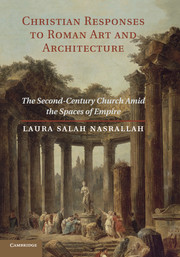 Christian Responses to Roman Art and Architecture
Christian Responses to Roman Art and Architecture Book contents
- Frontmatter
- Contents
- LIST OF FIGURES
- ACKNOWLEDGMENTS
- ABBREVIATIONS
- INTRODUCTION
- PART I FRAMING THE QUESTION, FRAMING THE WORLD
- 1 WHAT IS AN APOLOGY? CHRISTIAN APOLOGIES AND THE SO-CALLED SECOND SOPHISTIC
- 2 WHAT IS THE SPACE OF THE ROMAN EMPIRE? MAPPING, BODIES, AND KNOWLEDGE IN THE ROMAN WORLD
- PART II INTO THE CITIES
- PART III HUMAN BODIES AND THE IMAGE(S) OF GOD(S)
- EPILOGUE
- BIBLIOGRAPHY
- INDEX LOCORUM
- INDEX
- References
1 - WHAT IS AN APOLOGY? CHRISTIAN APOLOGIES AND THE SO-CALLED SECOND SOPHISTIC
from PART I - FRAMING THE QUESTION, FRAMING THE WORLD
- Frontmatter
- Contents
- LIST OF FIGURES
- ACKNOWLEDGMENTS
- ABBREVIATIONS
- INTRODUCTION
- PART I FRAMING THE QUESTION, FRAMING THE WORLD
- 1 WHAT IS AN APOLOGY? CHRISTIAN APOLOGIES AND THE SO-CALLED SECOND SOPHISTIC
- 2 WHAT IS THE SPACE OF THE ROMAN EMPIRE? MAPPING, BODIES, AND KNOWLEDGE IN THE ROMAN WORLD
- PART II INTO THE CITIES
- PART III HUMAN BODIES AND THE IMAGE(S) OF GOD(S)
- EPILOGUE
- BIBLIOGRAPHY
- INDEX LOCORUM
- INDEX
- References
Summary
When i teach about early christianity in the roman empire, I explain to my students that the early Christian apologists are not apologizing. The second-century Christian Justin writes:
To the Emperor Titus Aelius Hadrianus Antoninus Eusebes [i.e., Pius] Augustus; and to his son Caesar, Verissimus the Philosopher; and to Lucius the Philosopher, the natural son of Caesar and the adopted son of Pius, a lover of paideia; and to the sacred Senate, with the whole People of the Romans, I, Justin, the son of Priscus and grandson of Bacchius, from the city of Flavia Neapolis in Syria Palestine, have made this address and petition on behalf of those of every race who are unjustly hated and abusively threatened, myself being one of them.
Justin's slightly later contemporary Athenagoras pleads: “I need, as I begin to defend our doctrine (ἀναγκαῖον δέ μοι ἀρχομένωι ἀπολογϵῖσθαι ὑπὲρ τοῦ λόγου δεηθῆναι ὑμῶν), to beg [you], greatest emperors, to listen equitably to us, and not to be prejudiced, carried off by the common and irrational rumor – to beg you to turn your love of learning and love of truth toward our speech” (Leg. 2.6). But certainly Justin and Athenagoras are not sorry. They are not backing down or making up. Rather, through their rhetoric they assert a situation in which they defend themselves, their religion, and their communities in the face of the oppressive powers and possible persecution of the Roman Empire.
- Type
- Chapter
- Information
- Christian Responses to Roman Art and ArchitectureThe Second-Century Church amid the Spaces of Empire, pp. 21 - 50Publisher: Cambridge University PressPrint publication year: 2010


